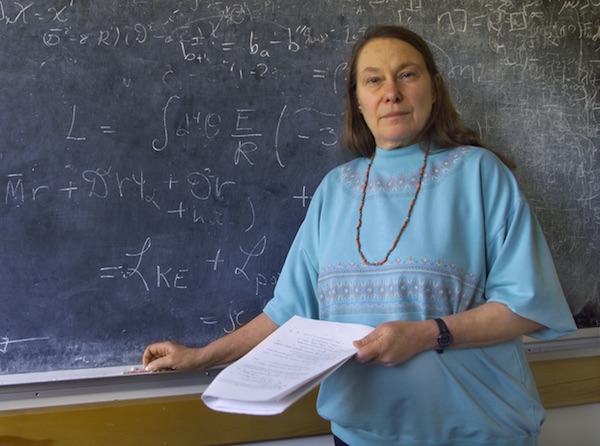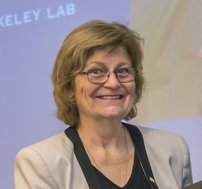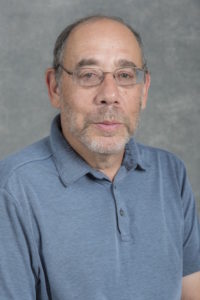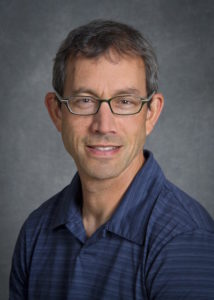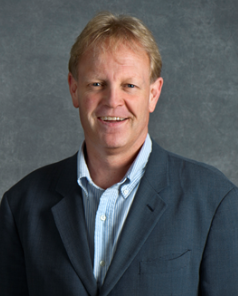Five scientists from the Department of Energy’s Lawrence Berkeley National Laboratory (Berkeley Lab) have been named Fellows of the American Association for the Advancement of Science (AAAS). Election as a AAAS Fellow is an honor bestowed upon AAAS members by their peers.
They are:
- Eleanor A. Blakely (Biological Sciences)
- Mary K. Gaillard (Physics)
- Howard S. Matis (Physics)
- Krishna K. Niyogi (Biological Sciences)
- David K. Shuh (Chemistry)
Blakely was recognized for her “distinguished contributions to the field of biophysics, particularly to the biological effects of radiation relevant to cancer therapy and to travel in space.”
Blakely joined Berkeley Lab in 1975 and worked with John Lawrence, a pioneer of nuclear medicine and brother of Ernest Lawrence, Berkeley Lab’s namesake. She did much of her work at the Bevalac, which could accelerate ions as heavy as uranium to high energies. Some of her research involved working out which would be the best beam for cancer therapy. She also studied the effect of radiation on cataracts, which concerns not only cancer patients, but also astronauts, and is a field in which she is a leading expert. Last year she was awarded the Berkeley Lab Citation for her extraordinary achievements in science.
Gaillard was recognized for her “outstanding contributions to the phenomenology of gauge theories, both in and beyond the standard model, and for inspiring women physicists worldwide.”
Gaillard became UC Berkeley’s first female physics professor in 1981 and joined Berkeley Lab the same year. She published a memoir last year, “A Singularly Unfeminine Profession: One Woman’s Journey in Physics,” in which she wrote about the slights and frustrations that gradually raised her consciousness as she rose to the top among theoretical physicists trying to understand the complexities of the universe’s fundamental particles. She raised three young children while simultaneously laying the theoretical groundwork for key experiments that proved the validity of the Standard Model, now accepted as the best description of three of the four forces of nature.
Matis was recognized for his “leadership roles in advancing physics knowledge through the APS (American Physical Society) and CPEP (Contemporary Physics Education Project), and for his development of a cosmic-ray detector used by schools nationwide.”
Since 2012, Matis has served as president of the CPEP, an international nonprofit organization of educators and physicists that produces materials to explain physics concepts. A Berkeley Lab physicist since 1983, Matis has also led the Berkeley Lab Cosmic Ray Telescope Project, which provides instructions on how to build a simple, cost-effective particle detector. Matis has worked on particle detectors for experiments at CERN’s Large Hadron Collider and at the South Pole, among others. He was honored by the APS with the 2017 Excellence in Physics Education Award.
Niyogi was recognized for his “pioneering investigation of the regulation of photosynthesis and mechanisms of photoprotection in plants and algae.”
Niyogi’s research interest lies in understanding how photosynthetic energy conversion works, how it is regulated, and how it might be improved to help meet the world’s needs for food and fuel. He is also a Howard Hughes Medical Institute–Gordon and Betty Moore Foundation Investigator and a professor in the Department of Plant and Microbial Biology at UC Berkeley. Earlier this year he was elected to the National Academy of Sciences.
Shuh was recognized for his “distinguished contributions to actinide chemistry, in particular for pioneering spectroscopic characterization of bonding in actinide materials with soft X-ray synchrotron radiation.”
Shuh, who joined Berkeley Lab in 1992, serves as director for the Glenn T. Seaborg Center, which explores the molecular-scale chemical interactions of heavy elements and also has a mission to educate and train scientists in this field, known as actinide science. Shuh also leads the Heavy Element Chemistry Program and Heavy Element Research Laboratory Program. He is a principal scientist for the Molecular Environmental Sciences Beamline at Berkeley Lab’s Advanced Light Source synchrotron and is considered an expert in exploring the electronic structure and chemistry of actinides and rare-earth elements using synchrotron-based experiments and other techniques.
This year 391 members have been awarded this honor by AAAS because of their scientifically or socially distinguished efforts to advance science or its applications. New Fellows will be presented their awards on February 18 during the 2017 AAAS Annual Meeting in Boston. The tradition of AAAS Fellows began in 1874.
# # #
Lawrence Berkeley National Laboratory addresses the world’s most urgent scientific challenges by advancing sustainable energy, protecting human health, creating new materials, and revealing the origin and fate of the universe. Founded in 1931, Berkeley Lab’s scientific expertise has been recognized with 13 Nobel prizes. The University of California manages Berkeley Lab for the U.S. Department of Energy’s Office of Science. For more, visit www.lbl.gov.
# # #
The American Association for the Advancement of Science (AAAS) is the world’s largest general scientific society and publisher of the journal Science (www.sciencemag.org) as well as Science Translational Medicine, Science Signaling, a digital, open-access journal, Science Advances, Science Immunology, and Science Robotics. AAAS was founded in 1848 and includes nearly 250 affiliated societies and academies of science, serving 10 million individuals. Science has the largest paid circulation of any peer-reviewed general science journal in the world. The non-profit AAAS (www.aaas.org) is open to all and fulfills its mission to “advance science and serve society” through initiatives in science policy, international programs, science education, public engagement, and more. For the latest research news, log onto EurekAlert! (www.eurekalert.org), the premier science-news Web site, a service of AAAS. See www.aaas.org.
—Glenn Roberts contributed to this article
